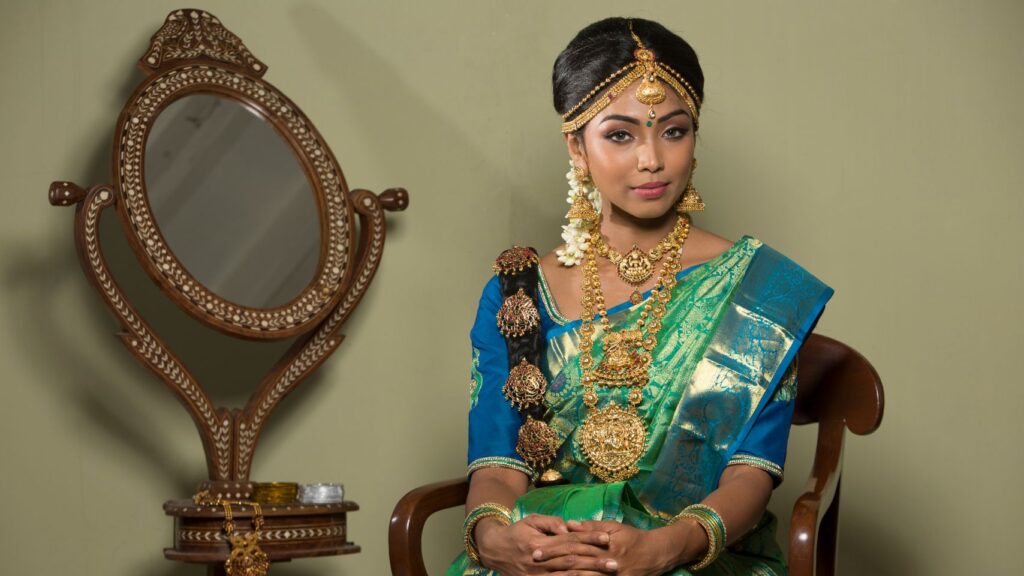- Home
- Culture & Community
- Incredible India
- Jewels of a Civilization: Indi ...
The Timeless Elegance of Traditional Indian Jewelry
Kundan, Meenakari, and Temple Jewelry
India, known as the “Golden Bird” in ancient times, has always been a land of immense wealth, cultural opulence, and artistic brilliance. Jewelry has played a significant role in Indian tradition, not only as an ornament but also as a symbol of prosperity, status, and spirituality. From kings to commoners, both men and women adorned themselves with exquisite gold, silver, and gemstone jewelry, making India a sought-after destination for traders and explorers from around the world.
Over time, with the influence of various dynasties, regions, and artistic styles, Indian jewelry evolved into a magnificent blend of craftsmanship and heritage. Today, these age-old traditions continue to thrive, with Kundan, Meenakari, and Temple jewelry standing as shining examples of India’s unparalleled artistry. As fashion changes and trends evolve, these jewelry styles remain timeless, allowing us to embrace our heritage with elegance, charm, and contemporary flair.
Kundan Jewelry: The Royal Legacy
Kundan jewelry, one of the oldest and most refined forms of Indian ornamentation, traces its origins to the Mughal era. Crafted with extreme precision, pure gold foil is used to set uncut gemstones such as diamonds, rubies, emeralds, and sapphires into intricate designs. This technique ensures that each piece radiates unmatched brilliance and grandeur.
Why Kundan Jewelry is Special
Craftsmanship: Skilled artisans meticulously place stones in gold settings without the use of adhesives, a technique requiring years of expertise.
Royal Affiliation: Historically favored by Rajasthani and Mughal royalty, Kundan jewelry is synonymous with opulence and luxury.
Modern Appeal: Today, it is a staple in bridal wear, adding a regal touch to wedding ensembles.
Famous for its elaborate designs and statement pieces, Jaipur remains the heart of Kundan jewelry craftsmanship, with families preserving this art for generations.
Meenakari Jewelry: The Art of Enamel Work
Meenakari jewelry is a breathtaking fusion of vibrant enamel painting and intricate goldsmithing, originating from Persia and perfected in Rajasthan during the Mughal period. The process involves fusing colorful enamels onto gold or silver surfaces to create detailed floral, peacock, and mythological motifs.
Why Meenakari Jewelry Stands Out
Exquisite Detailing: Each piece is adorned with delicate hand-painted designs in bold colors such as red, green, blue, and yellow.
Dual-Sided Beauty: Many Meenakari pieces are reversible, featuring intricate enamel work on one side and Kundan or uncut stones on the other.
Global Recognition: Popular in traditional and fusion jewelry, Meenakari continues to attract jewelry enthusiasts worldwide.
Cities like Jaipur, Varanasi, and Udaipur are celebrated for their mastery in Meenakari, with artisans passing down their techniques through generations.
Temple Jewelry: The Divine Ornamentation
Temple jewelry, deeply rooted in South India, was originally crafted to adorn deities in temples before being adopted by Bharatanatyam dancers and aristocrats. Made primarily in gold with elaborate carvings of Hindu gods and goddesses, these pieces symbolize purity, devotion, and prosperity.
What Makes Temple Jewelry Unique?
Mythological Motifs: Designs often include Lakshmi, Ganesha, peacocks, and temple pillars, representing divine blessings.
Pure Gold Craftsmanship: Traditionally handcrafted using high-karat gold, sometimes combined with rubies, emeralds, or pearls.
Cultural Significance: Worn during festivals, weddings, and religious ceremonies, temple jewelry is revered as a symbol of divine connection.
Chennai, Madurai, and Kumbakonam in Tamil Nadu are renowned hubs for authentic temple jewelry, continuing to produce masterpieces that blend history with modern elegance.

Preserving India’s Jewelry Heritage: Museums and Collections
Despite historical challenges, such as invasions and colonialism, which led to the loss of many original pieces, India has managed to preserve a significant portion of its jewelry heritage. Today, several museums across the country showcase these timeless treasures, allowing the public to appreciate the intricate craftsmanship and historical significance of traditional Indian jewelry.
Museums Showcasing Traditional Indian Jewelry
National Museum, New Delhi: This museum houses a comprehensive collection of traditional Indian jewelry, celebrating the diverse forms and genius of Indian craftsmanship. The Decorative Arts Gallery features artifacts from the 16th to the 20th century, including metalware and jewelry, reflecting the lifestyles and cultural heritage of Indian society. (National Museum India)
Amrapali Museum, Jaipur: Dedicated to Indian jewelry and decorative objects, the Amrapali Museum showcases over 800 objects, including fine jewelry, handcrafted antiques, and exquisite curios. The collection ranges from tribal jewelry in wood and metal to silver and gold pieces, illustrating the rich tradition and craftsmanship of Indian jewelry. (Amrapali Museum)
Alamkara – The Beauty of Ornament: An exhibition that explores the tradition of adornment in India, highlighting how gods were richly bejeweled, men proudly wore jewels, and women adorned themselves with intricate ornaments. This exhibition provides insight into the cultural significance and aesthetic beauty of Indian jewelry traditions. (Google Arts & Culture)
The Enduring Charm of Traditional Indian Jewelry
Whether it’s the regal allure of Kundan, the colorful vibrancy of Meenakari, or the sacred symbolism of Temple jewelry, these art forms showcase India’s extraordinary craftsmanship and cultural heritage. Today, they remain an integral part of bridal trousseaus, festive adornments, and high-fashion jewelry collections worldwide.
As Indian jewelry traditions continue to evolve, these timeless styles uphold their legacy, ensuring that every piece tells a story of artistry, devotion, and unparalleled elegance.
Closing Note
India’s traditional jewelry reflects centuries of artistry, culture, and spiritual expression. While many treasures have been lost to history, the efforts of museums and curators continue to preserve and celebrate what remains. These pieces are more than ornaments—they are living stories of a heritage that continues to inspire and endure.





One reply on “Jewels of a Civilization: India’s Enduring Craft”
http://wish-club.ru/forums/index.php?autocom=gallery&req=si&img=5230